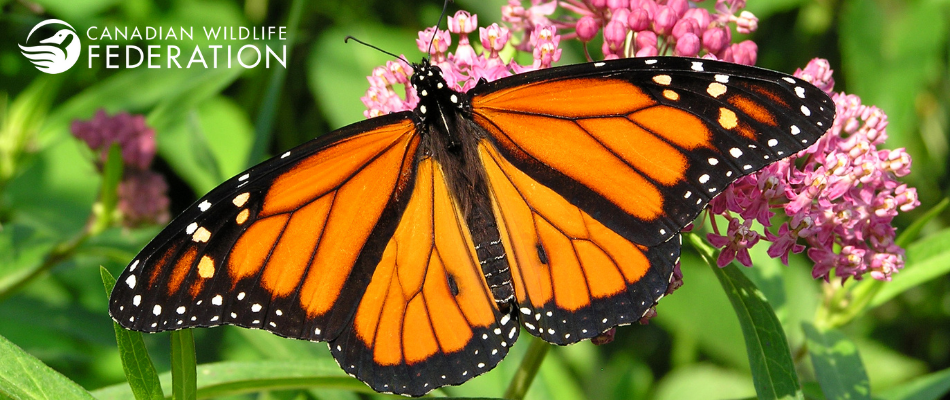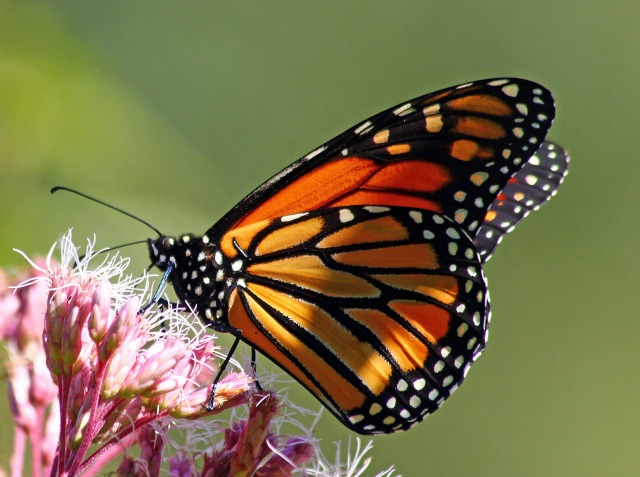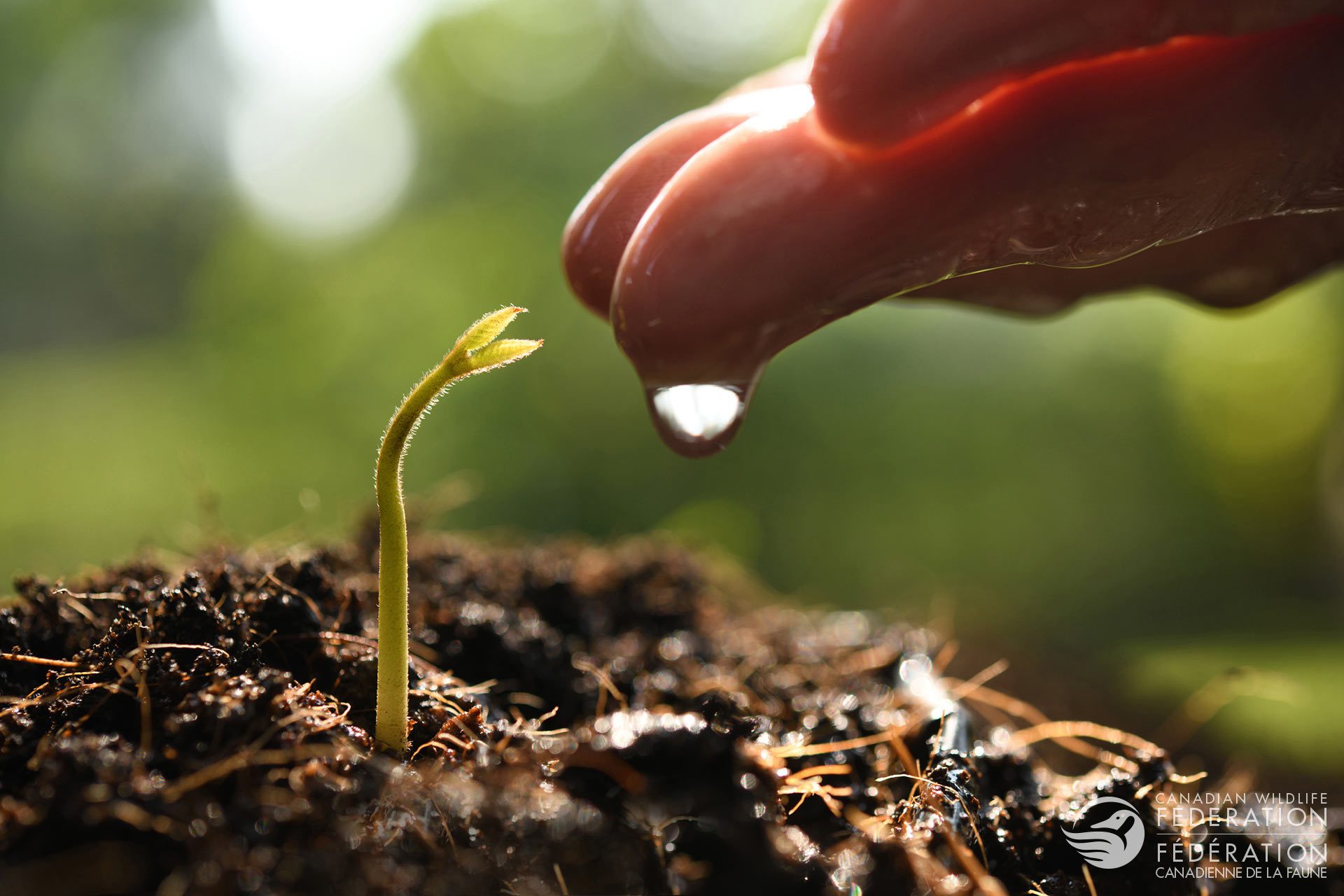Background
Across North America, populations of the iconic Monarch Butterfly are in steep decline. The brilliantly-coloured Monarch is a summer breeder in many areas of southern Canada, and most Canadian-born adults head to the highlands of central Mexico to overwinter. It takes three to four generations of Monarchs to return to Canada during the spring migration. Monarchs require both milkweed (the host plant of the Monarch caterpillar) and other wildflowers (a source of nectar) across the breeding range and migration routes.
In 2016, the Committee for the Status of Endangered Wildlife in Canada (COSEWIC) listed the Monarch Butterfly as Endangered. Monarch population decline is likely due to a combination of threats: habitat loss, use of herbicides and pesticides, and climate change.


Program Overview
CWF has a comprehensive and far-reaching Monarch conservation program. We conduct research, produce communications products, and work extensively with partners in Conservation Authorities, Counties, Municipalities and Corporations. The goals are to create and restore breeding and feeding habitats along public roadsides, rights-of-way (e.g. hydro-lines, pipelines, solar farms), and on marginal farmland.
In addition to active habitat restoration, CWF invests considerable expertise and resources in training events for our Networks of Municipal and Utility partners, where we leverage our connections with restoration experts throughout North America.
Our Monarch Conservation program expands annually as we take on new projects and strategies. And because Monarchs are considered an umbrella species for other pollinators, these projects also provide habitat for many other insect pollinators, such as bees.
Key Achievements
- 2018: Support from Ontario Trillium Foundation obtained, project launched with our partners Hydro One, Lanark County, and the National Capital Commission
- 2019: First workshop on restoring habitat for Monarchs and other pollinators for rights-of-way and roadway managers
- 2020: CWF initiates a new program to support rights-of-way managers in eastern Ontario in pollinator habitat restoration
- 2021 Monarch Migration Fieldwork begins
- 2021: The Canadian Chapter of the Rights-of-Way as Habitat Working Group is launched (this is connected to a larger group in the USA)
- 2021: Initiated a new Monarch habitat restoration program in southwestern Ontario with ECCC funding
- 2022: CWF expands on-the-ground support to rights-of-way managers in southwestern Ontario

Our Work for Monarchs

Monarch Habitat Science & iNaturalist
The majority of Canada’s Monarch Butterfly population migrates through Ontario each autumn on their way to Mexico. Their main migration routes are suspected to occur along lakeshores, but how their flight paths relate to landscape features is not clearly understood. This research project relies on the power of citizen science observations for large-scale modelling and mapping of Monarch flight and roosting areas. Join this project on iNaturalist today!
Rights-of-Way Habitat Networks
(Canadian Working Group & Communities of Practice)
This project creates nectaring and breeding habitat for Monarch Butterflies — an umbrella species for our native pollinators. CWF partners with rights-of-way managers along the Eastern Monarch migratory path to both actively and passively restore native wildflower meadows.


Marginal Farmland for Monarchs
Habitats that support flower species used by Monarchs are disappearing due to land use changes. This study aims to determine where marginal farmland that supports Monarch Butterflies still exists, how much is being lost, and thus where we most need to focus on habitat creation to support Monarchs and other pollinators. This is a research project undertaken with the University of British Columbia.
Native Pollinator Habitat Restoration in Ontario
This project, in Southwest Ontario, creates meadow habitat for Monarch Butterflies — an umbrella species for our native pollinators. Thanks to funding from the Government of Canada, CWF partners with other organizations to source local native seed and then actively restore wildflower meadow habitats. Areas close to the Great Lake shores are the specific focus for this project because they are known migration routes for Monarchs. However, other areas are also being restored in SW Ontario.


Canadian Seed Strategy Framework
A National Seed Strategy is critically necessary to support a sustainable supply of high-quality native plants (ethical, local, diverse, certified, climate-adaptive) across Canada. As Canadians are progressively interested in nature-based climate solution habit projects, there will be increased demand for native seed and seedlings to do restoration.
Interesting Facts



Become a Monarch Ambassador
Do you want to help the Canadian Wildlife Federation with Monarch Butterfly conservation? Monarch Butterflies are in steep decline across North America due to habitat loss, pesticide use and climate change. We are now in a critical period for their conservation and for ensuring Monarch Butterflies are still around for future generations! By joining our Monarch Group on iNaturalist Canada you can help us monitor this year's Monarch migration around the shores of southern Ontario's great lakes! As a volunteer member of our team, you will receive free training, webinar sessions and will contribute to important research as a community scientist!


You Can Always Help
by Adopting a Monarch Butterfly!
Monarchs Navigating Climate Change
As our climate changes, Monarch Butterflies may need to adjust their current range to find suitable habitat for reproduction and feeding on nectar, and this may include making more use of habitat in Canada. As climate change is resulting in more frequent extreme weather events, Monarch mortalities during migration and on overwintering grounds may increase, and thus additional habitat will need to be restored to buffer against population declines. Large scale and connected habitat on rights-of-way corridors in Manitoba, Ontario and Quebec will help reduce stress on the Monarch as our climate gets warmer.
In addition, native wildflower meadows improve ecological services. As we continue to restore and maintain native meadow habitat on rights-of-way, we improve pollination services, reduce the impact of flooding, reduce heat on land, create natural snow fencing and increase carbon sequestration.

Videos
In the News
-
Ramping Up Efforts To Protect The Monarch Butterfly
January 19, 2024, CKSX-FM – A national not-for-profit wildlife conservation group is expanding its efforts to protect the Monarch butterfly, which frequents areas of Chatham-Kent. The Canadian Wildlife Federation (CWF) has established networks across eastern and...
Papers & Handouts
Additional Resources
Program Lead
Carolyn Callaghan
My work focuses on the conservation of species at risk in Canada. I am interested in understanding the factors that put species at risk and then determining how to reduce the impact of these factors to recover populations. My team and I look for compatibility with farming practices and business practices on roadways and rights-of-way with the recovery of species at risk. We study a variety of species currently listed under Canada’s Species at Risk Act, including Western Chorus Frog, Monarch Butterfly, and more recently, grassland bird species such as Bobolink and Eastern Meadowlark.
“If we work together to restore meadow habitat in private and public lands, we can make a difference for the recovery of the Monarch Butterfly.”



































